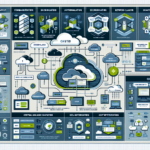Managing virtual machine (VM) templates effectively is essential for maintaining consistency, streamlining deployment processes, and ensuring scalability in a virtualized environment. Below are best practices and strategies for managing VM templates:
1. Standardize Template Creation
- Define a Baseline Configuration: Create templates with a standard set of configurations (OS, patches, security settings, applications, etc.) that align with organizational policies.
- Use Naming Conventions: Develop a clear and consistent naming convention for templates (e.g.,
AppServer-Windows2022-v1orUbuntu18.04-WebServer-v1). - Include Minimum Software: Avoid bundling unnecessary applications in templates to keep them lightweight and versatile.
2. Keep Templates Updated
- Regular Patching: Ensure all templates are updated with the latest OS and application patches to reduce vulnerabilities.
- Automate Updates: Use tools like PowerShell or Ansible to automate template updates across the environment.
- Test Updates: Before deploying updates, test them in a staging environment to avoid introducing issues into production.
3. Organize Templates
- Categorize by Purpose: Organize templates based on their use cases (e.g., web servers, database servers, Kubernetes nodes, etc.).
- Separate by Hypervisor: If using multiple platforms (e.g., VMware vSphere, Hyper-V, or Proxmox), ensure templates are stored separately for each hypervisor.
- Document Templates: Maintain documentation for each template, including its purpose, configurations, and software versions.
4. Centralize Template Management
- Use a Template Repository: Store templates in a centralized location, such as a shared datacenter datastore or a version-controlled repository.
- Leverage Image Registries: For containerized environments, use image registries (e.g., Docker Hub, private registry) to store base images for Kubernetes pods.
- Utilize Automation Tools: Use tools like VMware vCenter, Red Hat Satellite, or Terraform to manage templates efficiently.
5. Version Control
- Version Templates: Maintain different versions of templates (e.g.,
v1,v2,v3) to track changes and roll back if necessary. - Change Log: Document changes made to templates (e.g., software updates, configuration changes) for auditing purposes.
6. Security and Compliance
- Harden Templates: Apply security best practices (e.g., disable unnecessary services, configure firewalls) to reduce risks.
- Encrypt Sensitive Data: Ensure sensitive data is not embedded in templates (e.g., SSH keys, passwords).
- Compliance Checks: Periodically review templates for compliance with organizational and regulatory standards.
7. Optimize Storage
- Deduplication: Use storage deduplication features to reduce the size of template files.
- Thin Provisioning: Use thin-provisioned disks in templates to save storage space.
8. Monitor Usage and Lifecycle
- Retire Old Templates: Remove outdated or unused templates to avoid clutter and reduce management overhead.
- Track Template Usage: Monitor which templates are most frequently used to optimize resource allocation.
9. Integration with Automation Platforms
- Provisioning Tools: Integrate templates with provisioning tools like VMware vRealize Automation, HashiCorp Terraform, or Ansible for rapid deployment.
- Self-Service Portals: Provide users with access to pre-approved templates via self-service portals.
10. Backup Templates
- Backup Regularly: Ensure templates are backed up to avoid losing configurations in the event of hardware or software failures.
- Store Off-Site: Keep backups in a separate location for disaster recovery purposes.
11. Audit and Review
- Audit Templates Periodically: Conduct regular audits to identify outdated templates or security gaps.
- Solicit Feedback: Gather feedback from team members to improve template configurations and usability.
12. Leverage Template Cloning
- Create Clones: Use cloning features to create new templates based on existing ones, saving time and ensuring consistency.
- Customize Clones: Modify clones for specific workloads or use cases without affecting the original template.
By following these strategies, you can effectively manage virtual machine templates, ensuring consistency, scalability, and security across your IT infrastructure. If you have specific virtualization platforms (e.g., VMware, Hyper-V, or OpenStack), let me know, and I can provide tailored recommendations!



